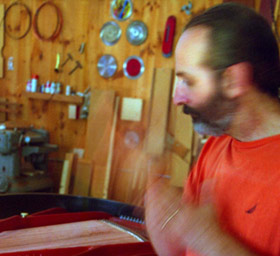Defining Your Ideal Touch
Your fingers know what they are looking for, but they speak a non-verbal language. How do we turn that language into words?
The pianist often has a global notion of what they want the touch to feel like. However, many pianists are not sure how to specify touch with words. I first ask them to try and translate their experience of touch into words.
The description is sometimes fuzzy, sometimes very clear, but either way, I listen to their choice of words, hear the emotion of the words, watch their hands as they approach and play the key, watch body and musculature when playing, get a sense of their muscular tone, and watch the way they like to move their bodies, listen to the way they play, and experiment with various touch parameters.
Then, we often “visit” various pianos. We play a number of pianos whose action design and inertia levels I am familiar with. If they have a piano they really have liked playing, I go to that piano, watch them play it, and then do an inertial analysis of that action. I try to gather as much data as possible to help target the inertia level that will satisfy their fingers… because their fingers know!
Sometimes, after visiting pianos, a pianist is exposed to an action which has a different touch than they are used to. Some will like the new touch, but be torn between targeting the feel they “know” as opposed to targeting this new “unknown,” but intriguing touch sensation. They think they might prefer the new touch, but are not sure… kind of like trying on a new pair and style of shoes. They will not know if they really like it until they play for a while.
Fortunately, I follow protocols which allow me to adjust the inertia level, should we opt for a “new” touch.

Often, the touch analysis is simpler than the above descriptions. Touch complaints can simply be caused by actions which are worn out and therefore poorly regulated. By simply replacing existing parts and doing a top-notch regulation/voicing, actions and touch can seem to be completely transformed.
Additionally, some “touch” complaints are not action problems at all, but misdiagnosed tonal issues. For example, there are pianos whose voicing or soundboards can only deliver one dynamic level… that dynamic being loud. No matter how the pianist works their technique, they can’t bring out the melody, the bass is overpowering, and the sound of their playing lacks focus. Since the keys and action are the pianist’s connection to the sound, it’s easy to mistakenly blame the action, and seek an action rebuild, when the belly is really the culprit.
The bottom line is that figuring out what the client’s touch preferences are requires “whole brain” diagnostic ability… I gather evidence from many vectors to guide the client and myself to defining ideal touch.
NEXT: The Touch Design Process >
Grand Piano Solutions ~ piano restoration and services
978-305-4692
serving Greater Boston, Central Massachusetts and New England
41 Parker Rd Shirley, MA 01464 ©2009

